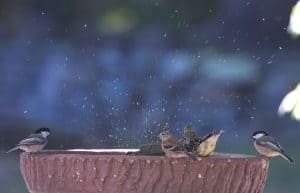
Hot enough for ya? This is the question I used to hear when I was growing up in Washington, D.C. And it was hot–in the 90’s most summer days. When we moved north to New England, we didn’t have nearly as much hot weather–only about two weeks a year when it was in the low 90’s. But things have changed: The big news this month is that July 3, 4, 5, 2023 were the hottest days ever recorded on earth. In fact, the entire month of July was the hottest month ever recorded on earth.
In a July 6 article by Margaret Osborne, Smithsonian Magazine reports that this unprecedented heat can be attributed to “a combination of human-caused climate change and El Nino, which has a global warming effect” (The El Nino weather pattern can dramatically warm the sea surface). Though official recording of Earth’s temperature only began in the 1850’s, Paul Ceppi, a climate scientist at Imperial College London, states that temperature estimates based on data from tree ring and ice core data, show that these are the highest temperatures Earth has seen in millennia: “These data tell us that it hasn’t been this warm since at least 125,000 years ago….Looking to the future, we can expect global warming to increase, and hence temperature records to be broken increasingly frequently unless we rapidly act to reduce greenhouse gas emissions to net zero. Friederike Otto of the Grantham Institute states: ” It just shows that we have to stop burning fossil fuels– not in decades, now”.
The latest Intergovernmental Panel on Climate Change report states that “Immediate, deep, rapid and sustained green house gas emissions reductions are needed to slow down global warming”. U.N. Secretary-General Antonio Guterres states, “We have never been better equipped to solve the climate challenge–but we must move into warp speed climate action now. We don’t have a moment to lose.”
Visit the Westford Climate Action website, westfordclimateaction.org for information about what you can do to lower your carbon footprint, and become part of the solution.
Many thanks to flora and fauna reporters for the month of July. Please send August reports by August 31 for inclusion in next month’s column. You can e-mail me at mariancharman@gmail.com.
July Reports:
Marian/Bill Harman, Old Colony Drive. July 4, 70’s, rainy and humid. We have been quarantining since July 2, when Bill tested positive for Covid—Yikes! He has had a bad sore throat, low fever, very tired. Thank goodness for the bird feeder: pair of cardinals, juvenile hairy woodpecker, juvenile red-bellied woodpecker, titmouse, juvenile grackles and red-wings. July 5, 70’s, sunny, humid. Scarlet tanager heard in the yard. A Carolina wren all upset in the tree in front—is it fledging day? July 7, 80’s, humid. A juvenile blue jay flew to the roof, calling and begging insistently for the parent bird. July 7, first lightning bugs seen here, along the weedy edge between lawn and woods. Their flash is orange, a double and a single flash. July 9, 80’s, very humid. A juvenile flicker is trying out the feeders. He decided on the suet, but was driven off by grackles. I took a walk on the beaver dam trail to see what’s happening in the neighborhood. There were lots of mosquitoes and black flies. I needed my mosquito netting headpiece over my hat. A few blueberries have ripened, so I tried some—good! White water lilies are blooming en masse on both the pond and the brook—beautiful. Lots of swamp honeysuckle blooming in the swamp and around the pond—very fragrant. About twenty of the downy rattlesnake plantains have tall flower stems and buds. Birds heard/seen: a large number of juvenile red-wings seemed to have just fledged from the swamp near the pond; lots of commotion with parent birds running interference against other birds to protect their young. One Eastern wood-peewee, one veery, lots of catbirds, one white-breasted nuthatch, some blue jays, a downy woodpecker, a cardinal singing, a brown creeper singing beautifully, goldfinches, a Northern flicker. New to me: beaked hazelnut tree/shrub. There were several, long green “beaked” pods seen on it. When they are brown and dry, they will contain nuts. These were first pointed out to me by Nancy Eberiel, who found them along Stony Brook. Lots of mushrooms are up along the trail: white, pale brown, brown with flecks, orange and dark orange with a suede texture. July 17, Lots of large yellow mushrooms are coming up in the grass all along our roads. One indian pipe plant seen on Old Colony Drive. July 22, garter snake on our cement walk. She is about 2 feet long. I call her “Gertie”. Fish crows heard in the trees. Many young jays, grackles, titmice around. Lots of bunnies of all sizes on the lawn: adults, teenagers, babies only 4-6” long. They are too fearless and allow me to get very close. A very hot and buggy walk on the beaver dam trail: pinkish mushrooms, some ripe high bush blueberries—I tried a few—sour. A large owl pellet in the trail, which had some large shreds of bone in it. I was wearing my mosquito netting hat, and the young grackles were very upset about it. They set up quite a commotion, flying back and forth across the trail in front of me. A chickadee joined with a few “dee-dees”, but soon realized who I was and flew away. Sweet pepperbush about to bloom. Snake Meadow Brook is flowing fast due to all the rain, and making quite a lovely sounding waterfall over the beaver dam. Buttonbush and pickerelweed blooming. July 26, I have been watching a spider outside the kitchen window. She was able to catch some bugs to eat for the past month, and after ingesting a large beetle, her abdomen seemed enormous. The next day she laid a very large egg sac that she spent a lot of time winding in spider silk. Now she rests with one leg on it, protecting it. There is another smaller spider that keeps coming over to try to
inspect it, but “Charlotte” spider repeatedly fights off the small intruder. July 29, hot and humid as usual. Because of the heat and having an old dog to care for this week, we have been taking several short walks on the road this week. Lots of very annoying mosquitoes and black flies. I hear a pee-wee’s lovely song repeatedly, robins and blue jays. July 30, sunny, 70’s. Finally a thunderstorm and cold front brings blessed relief from the heat and humidity!
Tom Ennis, Almeria Drive. July 6, we are having an invasion of purple loostrife and garlic mustard in the yard (Its very wet in the grass).
Diane Duane, Howard Rd. July 7, a milk snake [Diane sent a nice photo of a light colored milk snake curled up-MH]
Jim O’Connell, Misty Lane. July 8. This is the second year of our wildflower meadow (unmowed back yard), and for the first time we saw lots of fireflies last night!
Rosemarie Koester, Providence Rd. July 27, more hummingbirds at the feeder than we have had before. We have to refill the feeders twice a week. Too many bunnies are eating my special hostas. Heard a young hawk calling from the woods where they must have a nest. In the yard, house finch, goldfinches, downy woodpecker, robins, chipmunks and squirrels. We have lots of tall milkweed plants now, but no takers so far. A few carpenter ants here, but they suddenly disappeared. There are lots of mushrooms at East Boston Camps.
Marian Harman is a member of the Westford Conservation Trust, Inc. a non-profit conservation organization, whose purpose is the preservation of Westford’s open spaces and trails. The Trust welcomes new members and volunteers. Check out the Trust’s website at westfordconservationtrust.org and visit us on Facebook.
